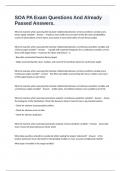Tentamen (uitwerkingen)
SOA PA Exam Questions And Already Passed Answers.
- Vak
- Instelling
What to examine when assessing the bivariate relationship between a Factor predictor variable and a binary target variable? - Answer A table to asses (with rows as factor levels) the mean probabilities, counts of observations of each factor, and counts of each observation of each binary target. ...
[Meer zien]



